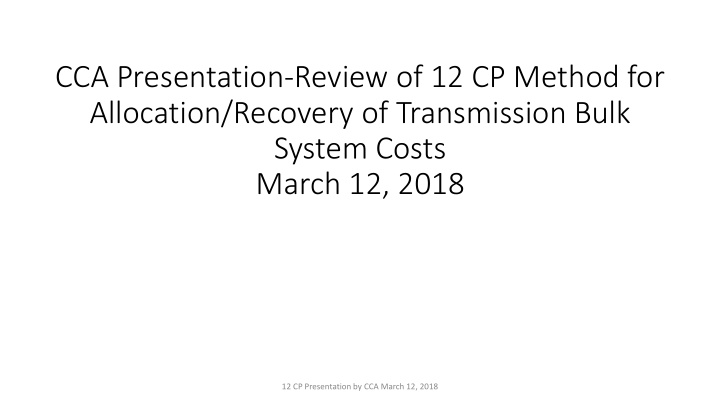



CCA Presentation-Review of 12 CP Method for Allocation/Recovery of Transmission Bulk System Costs March 12, 2018 12 CP Presentation by CCA March 12, 2018
Changing System • The Appendix to the December 2017 Alberta Energy paper describes the changing characteristics of the Alberta electricity system as follows: • In Alberta, periods of system stress do not generally occur at the same time as peak demand, with approximately 50 per cent of stress periods occurring between July and September, while peak demand commonly occurs in either December or January. This disconnect is expected to widen as renewable penetration increases. System stress periods in Alberta can also have significant annual variance with zero occurrences in some years (2015 and 2016) and up to eight occurrences in other years (2011 and 2013). 12 CP Presentation by CCA March 12, 2018
Peak Load No Longer the Primary Driver • In the past, periods of system stress occurred during times when peak load conditions existed. In other words load (or demand) was the primary driver for expansion of the system. • In a vertically integrated world, it was important to size bulk system additions in order to ensure adequacy of transmission capacity during peak load conditions when the probability of system stress was relatively high. • Under the old planning paradigm for supply and use of electricity, the use of the loss of load expectation method for determining reserve requirements, and the allocation of capacity costs on the basis of a single or multiple coincident peaks or weighted energy approaches would have been appropriate since load, or demand, was the primary driver of system stress and therefore of system expansion. Under those circumstances it made sense to provide strong incentives to reduce demand during peak periods in order to optimize system costs 12 CP Presentation by CCA March 12, 2018
High System Stress Periods Not Correlated with high Load Periods • The current and go forward bulk system planning would need to consider net demand variability and frequent cycling of units due to significant intermittent renewable resources, multi directional and multitemporal load flows, increasing use of integrative smart grid technologies and demand time shifting as a result of the deployment of storage. • Net demand variability and multidirectional load flows would not be correlated with high demand periods and can occur in any hour. This means planning of bulk system must recognize the need for adequate bulk system capacity in any hour. 12 CP Presentation by CCA March 12, 2018
A Principled Approach Must Consider Relative Probability of a Load Increment Causing System Stress if added during peak vs outside peak hours • Rather than providing strong incentives under the coincident peak method to shift demand from peak demand hours to all other hours or even providing somewhat weaker incentives under an energy based methods such as use of on-peak/ off-peak energy, a more nuanced approach is required where by fixed bulk system costs are allocated/recovered recognizing the probability of a load increment causing bulk system additions (on a planning basis), if incurred during peak load hours versus the hours outside peak load hours. • If there is equal probability that an increment of load would cause bulk system additions (on a planning basis), if incurred during peak load hours versus the hours outside peak load hours, then a non coincident peak or NCP recovery of bulk system costs from all connected loads would be appropriate 12 CP Presentation by CCA March 12, 2018
Data requirements • Load analysis by major bulk system lines based on recent historical data: A. Probability of highest 5 hours for each line (planning system) occurring at the same time as the system coincident peak hour, by month (include summary statistics) B. Based on A, calculate the probability of the peak hours for all lines occurring at the same time as the system coincident peak hour, by month • Simulated analysis of go forward system with increase in frequency of cycling and increasing NDV • Provide an estimate of the probability of bulk system line peaks occurring at the same time as the 12 CP hours 12 CP Presentation by CCA March 12, 2018
Possible Reforms to Bulk System Cost Recovery • Bulk system cost recovery based on higher of CP or NCP times X% (Probability of line peaks occurring at the same time as 12 CP hours; Ontario uses 85%). • Increasing self generation with multi directional, multitemporal flows means price signals reflecting cost causation should be provided to generation in as much as to load • All market participants must pay injection and withdrawal charges to access the bulk system. • All generators including behind the fence (BHF) would have separate contracts to access the bulk system • Bulk system considered as the physical system where primarily all inflows and outflows occur • Generator access charges or credits should reflect cost causation in relation to regional system (no wires charges/credits for Generation directly connected to bulk system) • Load would continue to pay 100% of bulk system wires costs 12 CP Presentation by CCA March 12, 2018
Rate Making is a forward Looking Concept • Transmission pricing must provide forward looking price signals consistent with current and go forward planning • Historical planning may help inform the future; however, this should not be determinative since future cost causation may differ substantially from the past • Need for gradualism in giving effect to changes in rate design • Imposing separate contracts and access tariffs for BHF generation may stem load defections • Steps toward reform ought to commence now-to provide right price signals for those contemplating new generation additions 12 CP Presentation by CCA March 12, 2018
Recommend
More recommend